Cryptocurrencies have taken the world by storm, bringing a wave of innovation to our daily lives and to the financial markets. Thus, there are now many businesses that offer crypto-related services, from informational resources to exchanges and trading platforms. And, considering that these businesses are almost entirely web-based, they rely heavily on internet traffic for profitability and growth.
One of the main ways for crypto websites to reach new clients is by ranking high on search engine results pages. Here is where search engine optimization comes into play, and one of the main ways of improving SEO for such a competitive niche is by building and managing a strong backlink profile. Here is our guide to the best backlink management practices and strategies for crypto websites to implement.
What Are Backlinks?
Simply put, backlinks are links that point to a website from a different website. They are also known as incoming or inbound links and are one of the most important components that contribute to a website’s search engine rankings.
When analyzing a website to determine its position in search engine results pages (SERPs), search engines take into account the website’s backlink profile. Google and other search engines consider both the quality and the quantity of links in their rankings. Thus, having a healthy backlink profile brings in many benefits, the most important of which are:
- Increased Trust: Inbound links from high-quality pages position your website as a resource that can be trusted. This has a positive impact on the rankings.
- Referral Traffic: When people find a link to your website on other pages and follow it, you get referral traffic, which signals to Google about users’ confidence in your authority and relevance.
- Improved Rankings for Target Keywords: Talking about relevance, getting a backlink from a referring domain that is relevant to your website topic helps you rank higher for your target keywords.
Consequently, a successful SEO strategy must include link building methods, preferably combining several approaches at once. For best results, your link building strategy should focus on not only the number of links but also their quality.
Link Quality vs. Quantity
Back when search engine algorithms were pretty basic, having many links was a surefire way to bring your website to the top of SERPs. It’s no surprise that website owners learned to manipulate this factor, building large backlink profiles without much attention to the quality of those inbound links. However, search engines have taken action and improved their algorithms to counter these manipulations.
Today, Google views links from sketchy domains, low-quality pages, or spammy sources as an attempt to manipulate the algorithm and may consider this a reason for penalties. That’s why a couple of high-quality backlinks can have a better effect than hundreds of low-quality ones.
The most effective crypto link building strategies should focus on acquiring high-quality backlinks and maintaining a healthy backlink profile. But how can you tell a healthy link profile from an unhealthy one, low-quality links from high-quality? Let’s take a look at some examples.
Low-Quality Backlinks
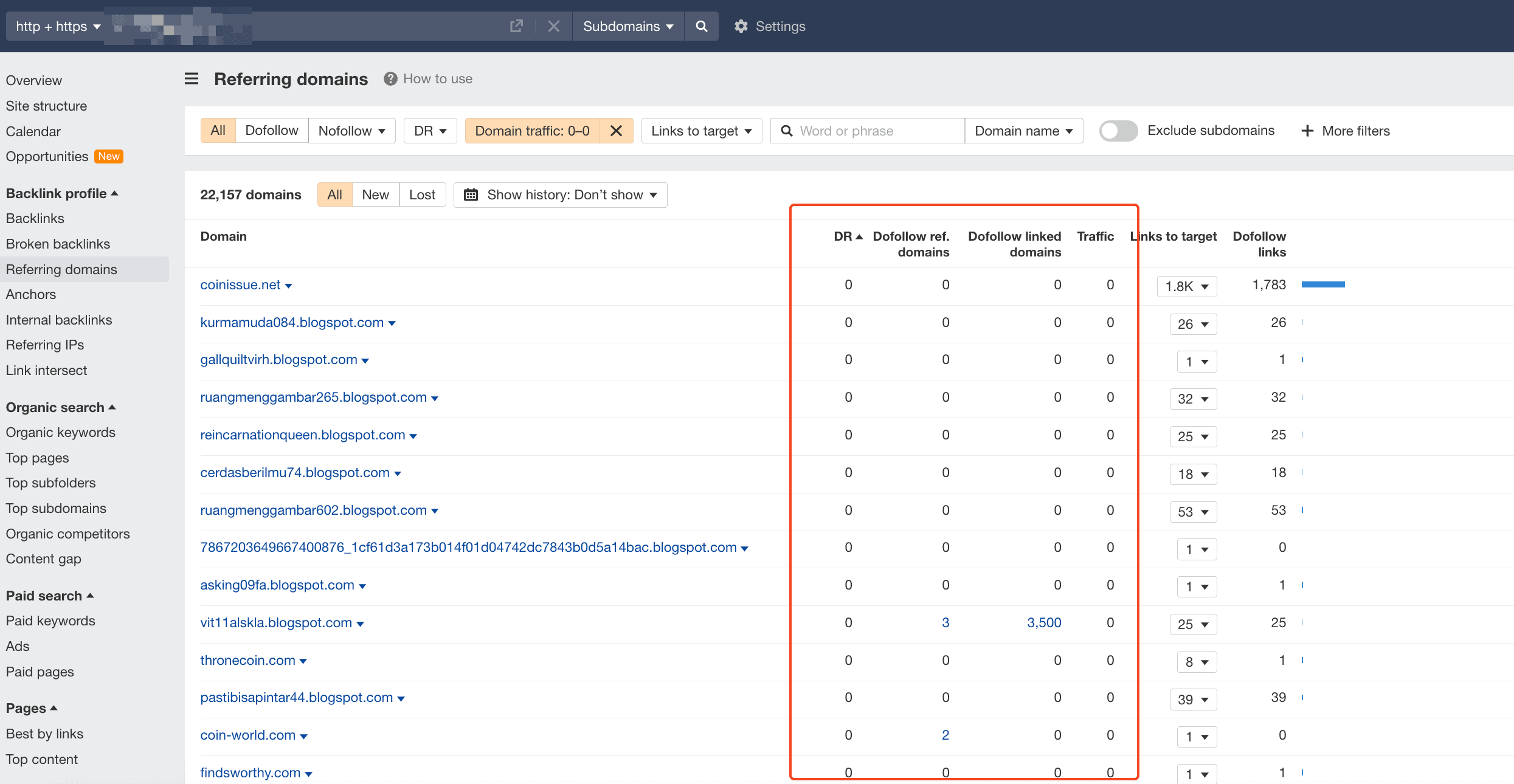
Here is an example of an unhealthy backlink profile from a crypto website. There are many “dead websites” in this profile, and although some of them may be related to the website’s crypto niche, these sites can get hacked or used for malicious purposes.
Also, these websites can be intermediaries with backlinks from other spammy websites. This can be a negative signal for Google when it comes to analyzing your website. That’s why it’s better to check such domains if you see them in your profile and remove the link if necessary.
High-Quality Backlinks
Of course, links from relevant websites help make your backlink profile healthier. See this example:
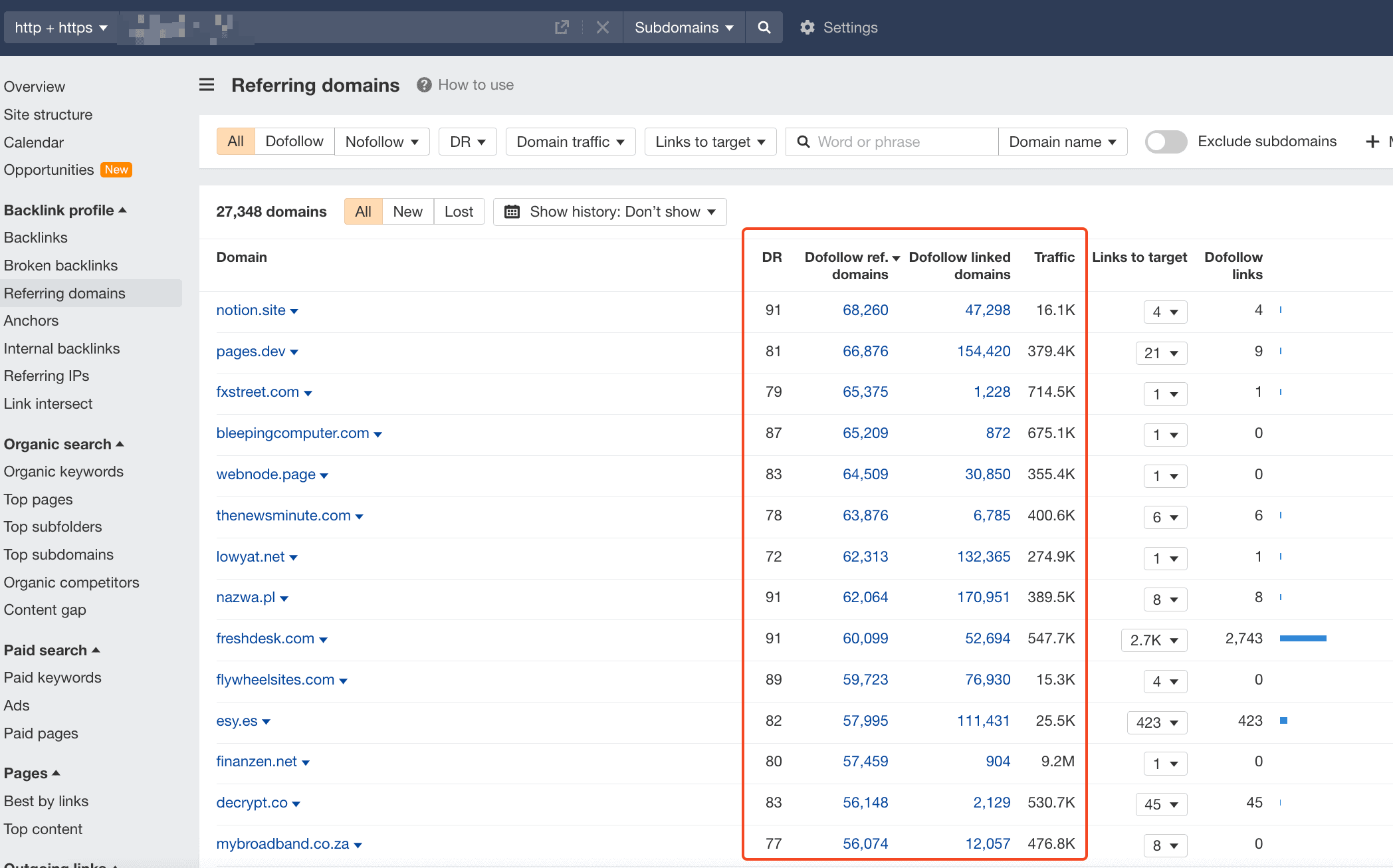
These are websites with large traffic volumes and Domain Ratings. However, it’s not always possible to obtain inbound links from such resources, especially if your brand is not well-established yet. So, you should focus on something simpler for a start. For example, crypto exchanges should look for websites with Ahrefs metrics that start from this:
- DR: 30+
- Traffic: 3,000+
- Traffic Value: $1,000+
- The number of referring domains should be higher than that of target domains
- The number of incoming links should be no more than 2-5 times larger than that of referring domains
There can be more metrics to consider when choosing referring domains; however, this is not the main focus of this article. In the following sections, I will share the best ways for crypto websites to manage links to ensure their backlink profile remains healthy.
Why Crypto Websites Need Effective Backlink Management
All SEO professionals and marketing specialists should have a solid understanding of their crypto website’s backlink profile and its condition. It doesn’t matter whether you work with a small personal blog or a large platform like Binance or Crypto.com. If you use link exchange methods or guest posting, you have to know what happens to those links. You should also monitor backlinks to prevent low-quality websites from linking to you.
This process can be divided into two types of tasks: link profile audit and backlink management and monitoring (which concerns the links you already have, especially those you obtained through your link building efforts). If you have any agreements with the representatives of the websites linking to you, you would probably be interested to know which of them bring you crypto traffic. It’s important to monitor this to see how effective the different traffic channels are.
Backlink management also gives you a competitive advantage. If there are many backlinks from sites with high domain authority in your link profile, it’s important to keep it that way, since it has a direct impact on your website’s search engine ranking and authority.
Monitor and Claim Lost Backlinks
In backlink management, one of the most important things to look out for is lost or broken backlinks. Even the most successful link building campaigns can encounter this issue: sometimes, websites close down, pages get deleted or redirected, or website owners decide to remove the link from their page. Losing a link can have negative effects on your SEO, such as:
- Loss of referral traffic (especially if you lose organic links);
- Decrease of authority and trust in the eyes of search engines;
- Poor user experience.
However, these consequences can be avoided or reverted. This is done through link reclamation, a process that involves contacting the website owner to find out why the link has been removed and whether they want to fix it. Many backlink management tools can help you determine lost links and decide if they are worth reclaiming.
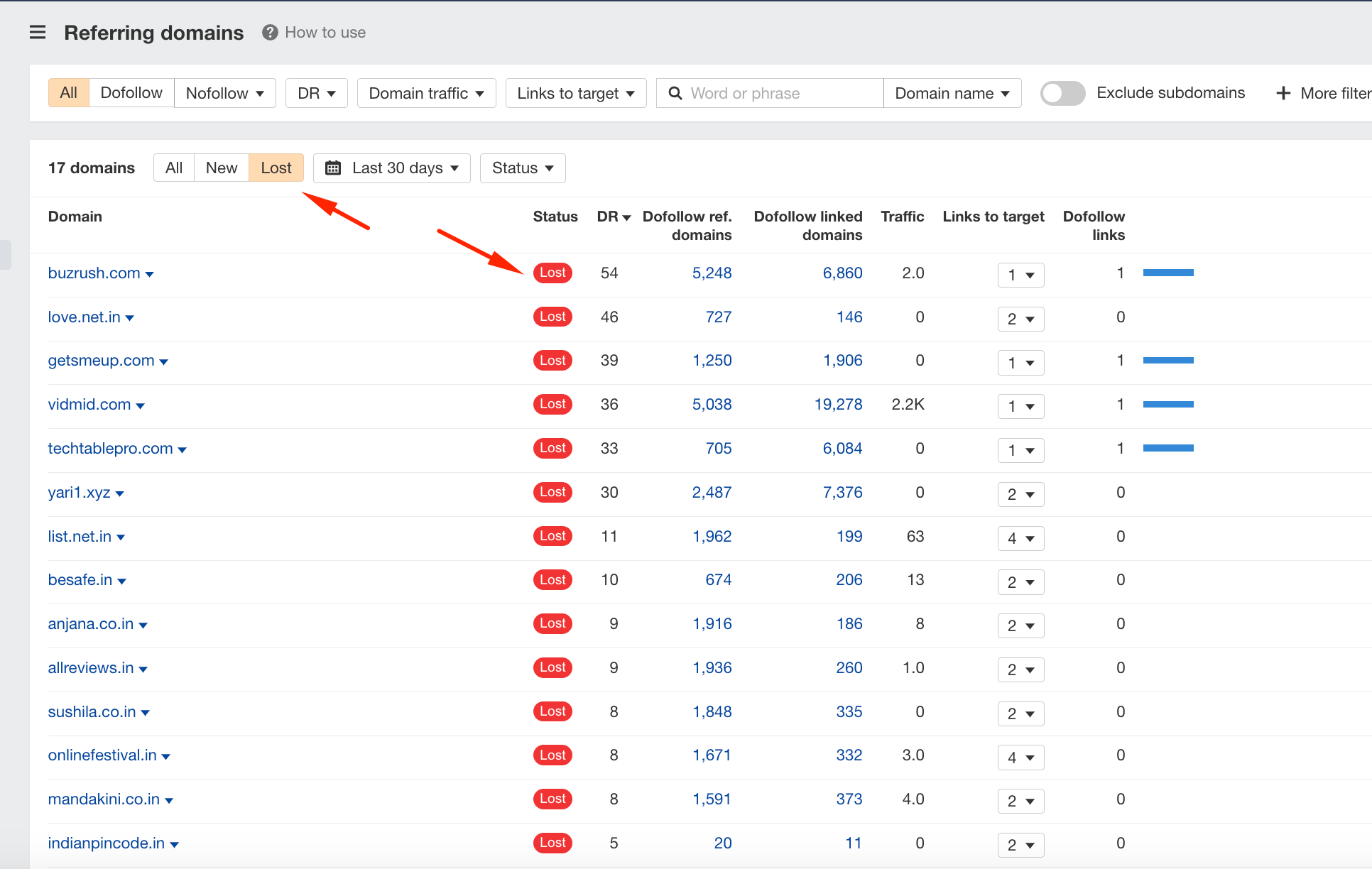
Check Spam Backlinks That Can Refer To Your Website
Spammy links are another issue that you should be aware of as a website owner. A spam backlink is a link pointing to your website from an irrelevant, low-quality website. Crypto websites should be especially careful with spammy links due to their competitive niche, in which spamming competitor websites with low-quality backlinks can be used as a negative SEO tactic.
While it should be fine if there are a couple of low-quality links in your profile, a large number of them can be seen by Google as an attempt to manipulate its algorithm. When left unchecked, spammy links can lead to demotion or strict penalties from the search engine. To find such links in your backlink profile, analyze it with a backlink management tool like Ahrefs or Google Search Console.
Here are some things that can give spammy sites away:
- A low DR;
- An irrelevant or sensitive topic website topic (e.g., adult content);
- A low traffic volume, suspicious traffic spikes, or rapid decreases in traffic volume;
- Numerous outbound links (more than inbound ones);
- Irrelevant or suspicious keywords;
- Suspicious inbound or outbound anchor texts (to sites with sensitive topics);
- No traffic from your relevant location (for example, you are optimizing for the USA and the website has traffic from India);
- The link was published without your consent or on a page that is not related in any way to your website/page.
Monitor Your Competitor’s Backlinks
Backlink management tools allow you to see your competitors’ inbound links. Why would you be interested in spying on your competitors? Well, if you are just starting out with crypto SEO, you can check which strategies they use to get to their positions in SERPs and borrow some of their methods for your project. This allows you to learn which link building campaigns are the most effective in the crypto niche.
Moreover, as you advance in the SEO process, seeing which keywords are promoted by your competitors is a great advantage. You can monitor the pages that get more links and analyze which keywords are used for that and how their content is optimized. This is especially important if one of your pages competes with that page for rankings.
Know Which Links Your Competitors Are Using
Aside from the abovementioned benefits of monitoring your competitors, you should also take a look at what types of links they get and which pages gain backlinks. In SEO tools for backlink management, you can analyze the pages their links are placed on. Those can be homepages, blog articles, profile descriptions, or other niche-related resources.
With this information on hand, check which of them bring more organic traffic and have more influence on the website’s SEO performance. Also, see what content attracts those backlinks. This will help you understand what content you should create or how to optimize your pages to get better results.
Compare Your Anchor Text Distribution with Competitors
One of the most valuable insights offered by backlink management tools is the anchor text distribution data. Several types of anchor text can be used for placing links:
- Relevant keywords as anchors;
- Naked URLs;
- Image links;
- Branded anchors;
- Generic/random text (like “this site” or “click here”).
Performing backlink management for your website and analyzing anchor text distribution in your competitors’ backlink profiles allows you to determine the optimal ratios of different anchor text types. This is important because over-optimized anchor distribution (numerous links with keywords as anchors) can draw suspicion to your website. Search engines may see this as a sign that you are using link building methods that go against their guidelines.
Control Link Distribution on Your Site
Different pages can draw different numbers of backlinks, having more or less impact on your SEO. In the backlink management process, you can see which of your website’s pages get more links, which helps define the type of content that performs best.
Moreover, checking link distribution on competitors’ websites gives you an insight into which pages they promote more, what is more important to them, and which types of pages or keywords can have higher or lower competition.
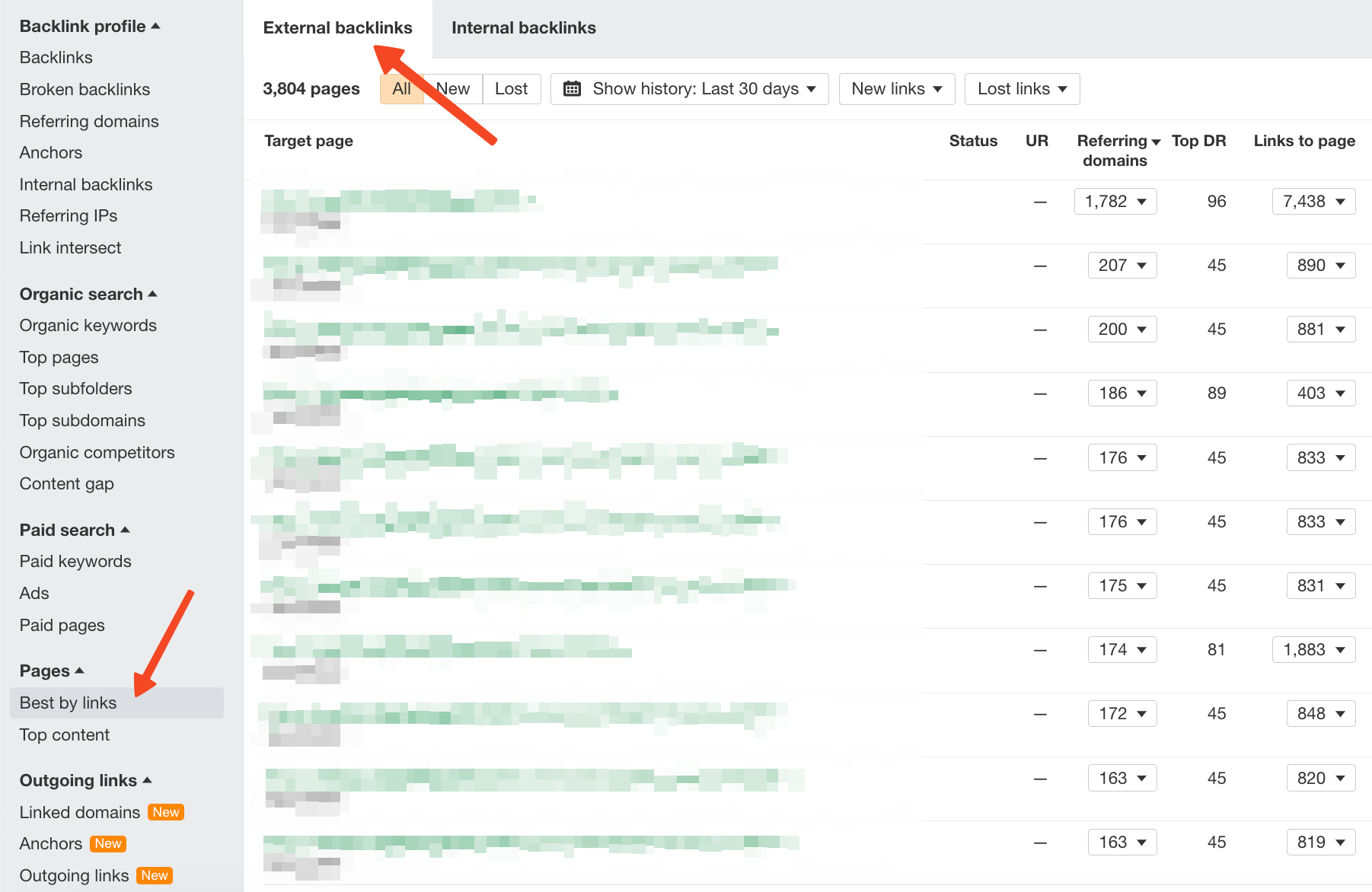
Manage Your Dofollow/Nofollow Links
The “nofollow” rel attribute is one of the key things to be aware of when doing SEO. Nofollow links are backlinks that are not taken into account by search engines when their bots crawl the page. This attribute was created to help fight algorithm manipulation: it’s mostly added to links in blog comments or similar public spaces to prevent spamming. Website owners can use this attribute when they feel like they have too many dofollow links on a page.
Having nofollow links in your backlink profile is not a bad thing. In general, a ratio of 60/40 is fine for dofollow/nofollow backlinks. This ratio can be different for your niche, however, so it’s important to analyze the competitors and see how many links that transfer value are necessary for you.
Follow the Dynamics of Link Growth of Your Site and Competitors
Link growth dynamics show how many links are obtained per day or month. The rate at which a website gets new backlinks is called link velocity, and it can be higher in popular websites and lower in new websites.
Compare your website’s link velocity with your competitors’ data to see which growth rate will be optimal. Keep in mind that it’s best to compare websites of the same scale. Many backlink management tools can provide you with built-in statistics, or you can use a backlinks report and compare data manually to determine your dynamics.
Disavow Unnecessary and Spammy Backlinks
We’ve talked about low-quality and spammy backlinks and how to find them, but what should you do when you see them? Links that have a bad impact on your SEO can be disavowed with Google’s disavow tool.
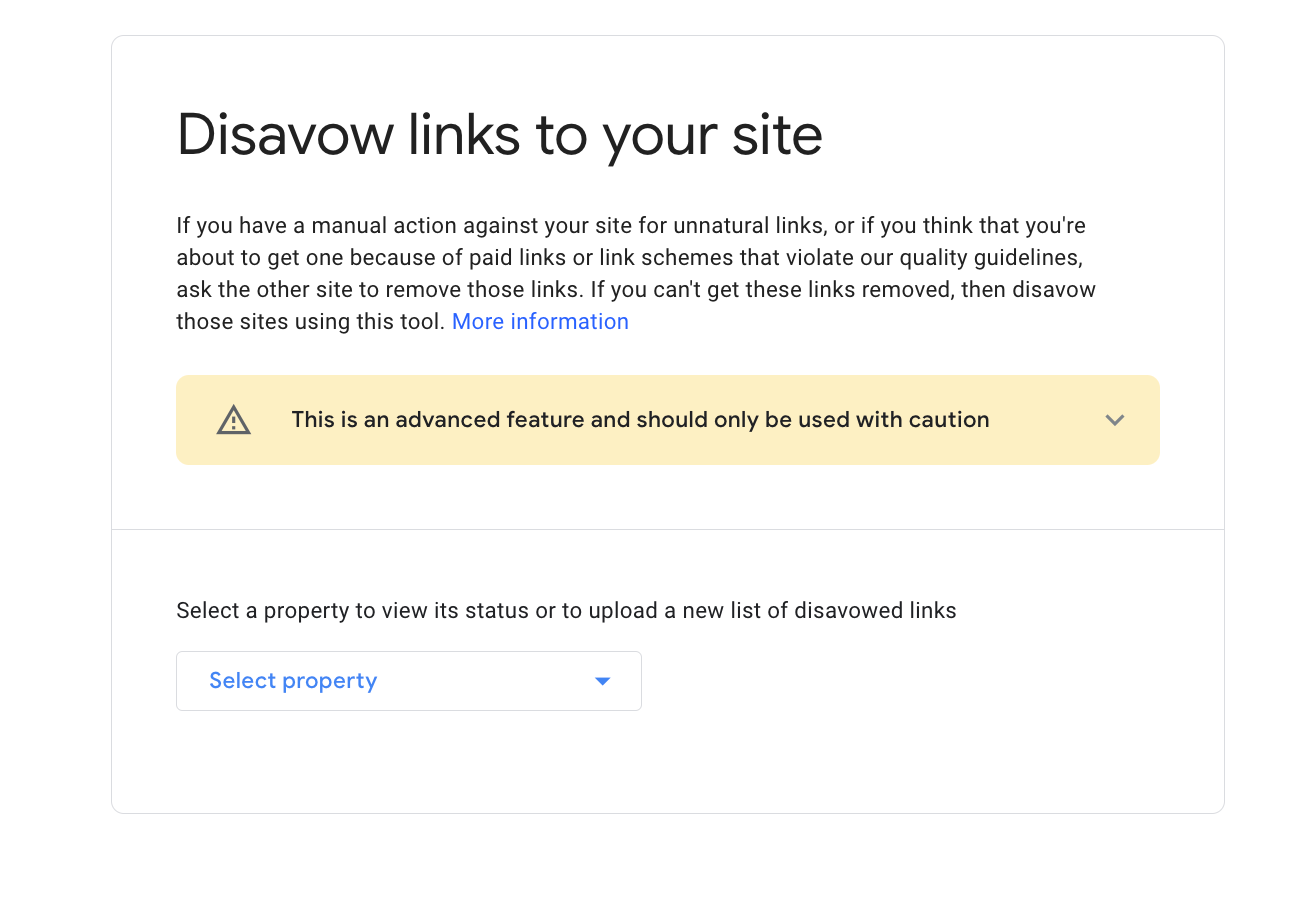
The disavow process is, undoubtedly, important, but you should be careful when removing links. Here, regular backlink management is essential: if you can detect and remove a harmful link in time, you can prevent its negative influence on your rankings. However, it is not recommended to remove more than 10% of a website’s links at a time. Otherwise, your rankings may be lowered quickly.
What Can Happen to Your Referral Links
One way or another, your backlinks are published on other websites. There is no guarantee that the referring domains will stay there and keep your backlink throughout your website’s lifetime.
The webmaster can delete the article that contains your link or edit the text and remove the backlink on accident. Sometimes, a link to your blog post can be replaced with a more up-to-date article.
For instance, we once worked with a crypto website that showed a decrease in certain positions. We did a website audit, analyzed the page, and checked if the website was optimized according to the most recent updates. Everything was fine.
However, when we started checking backlinks, we saw that some links from very high-quality referring domains were lost. We decided to reach out to the webmasters and reclaim the link. After this, the page returned to its top rankings within a few weeks.
How to Monitor Your Links
You can monitor and manage backlinks manually and automatically. Both methods are actively used in link building. Manual backlink management is the way to go for small websites with a low budget or sites that don’t need that many backlinks. Of course, you can also use tools like Ahrefs and Google Search Console in such cases. However, it’s larger websites with thousands of links that should monitor backlinks with special SEO tools to make the process more efficient.
Manual Link Monitoring
If you want to monitor backlinks manually, you’ll need to start gathering your backlink statistics. To do this, you can add your backlinks to a Google spreadsheet and update it with new links monthly. Here’s how it may look:

The following data should be included in your report:
- Anchor text and the URL of the target page (to understand which pages get the backlinks);
- Referring domain/page (to understand which page from the referring domain is linking to you);
- Link type (optional, but should be included if you want to understand the type of links);
- Domain Rating (also optional).
You can add other categories to your report, including whatever is most important to your campaign. The main data to add is the first two points and the date or at least the month when the link was obtained. The spreadsheet should be updated monthly.
With this spreadsheet, you can use Ahrefs to find out whether you lost any backlinks with the Lost Domains feature:
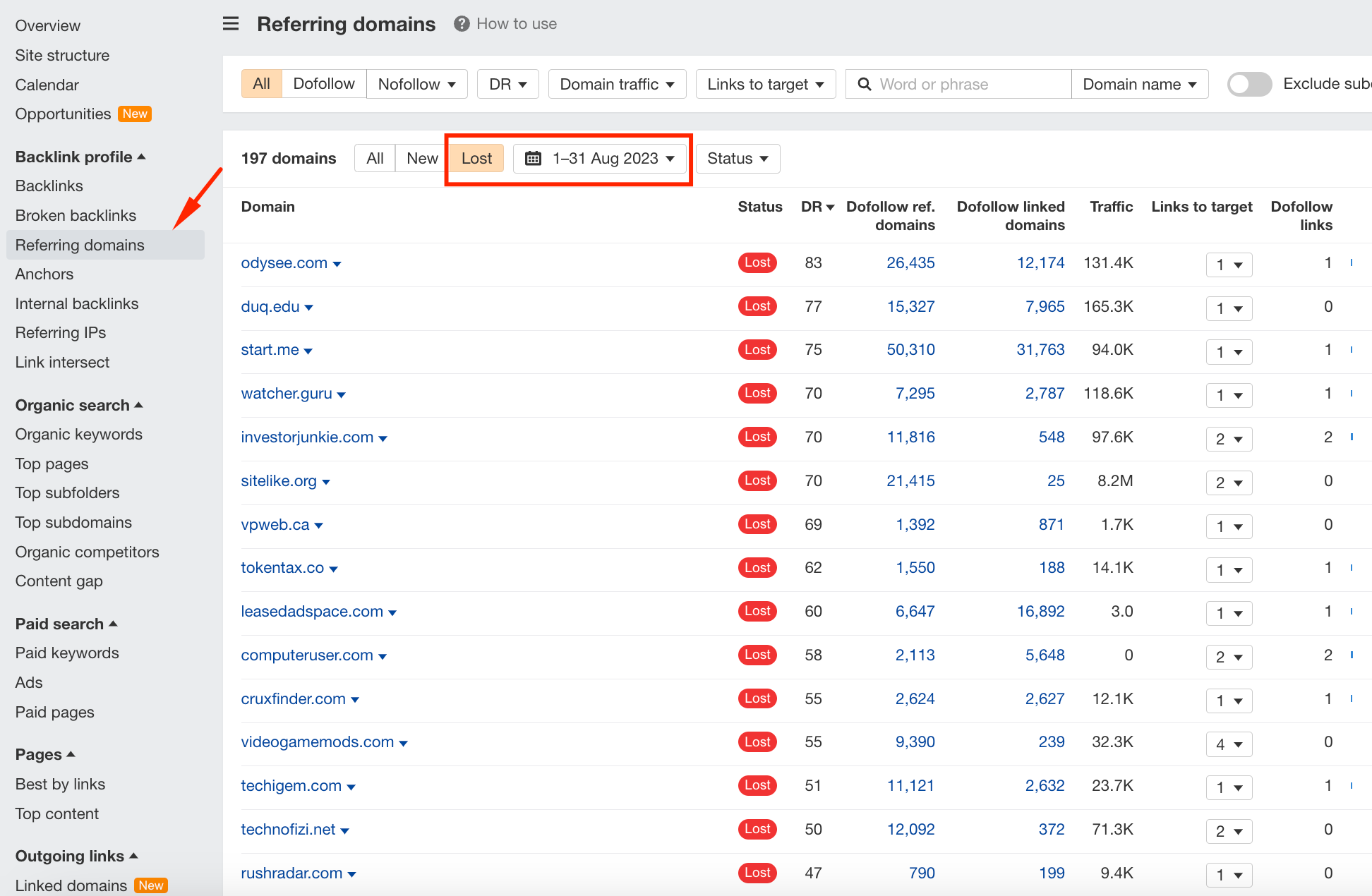
Naturally, you can analyze each valuable backlink manually every month. However, this is time-consuming and inefficient for large websites.
Link Management Tools
For a large backlink profile, special link management tools are a better choice. There are several SEO software options available, such as MonitorBacklinks, SERanking, etc. However, I prefer Linkchecker.Pro because it’s a simple tool with an easy-to-use interface created specifically for backlink management.
Things I Like About Linkchecker.Pro:
- It’s very easy to upload my links to the tool with a CSV or XML file and start monitoring their status right away.

- I can analyze any problems related to my backlinks when my link builder submits a report. Or I can check the backlinks I obtained, for example, a few months ago. The tool makes the statistics very clear and easy to understand:
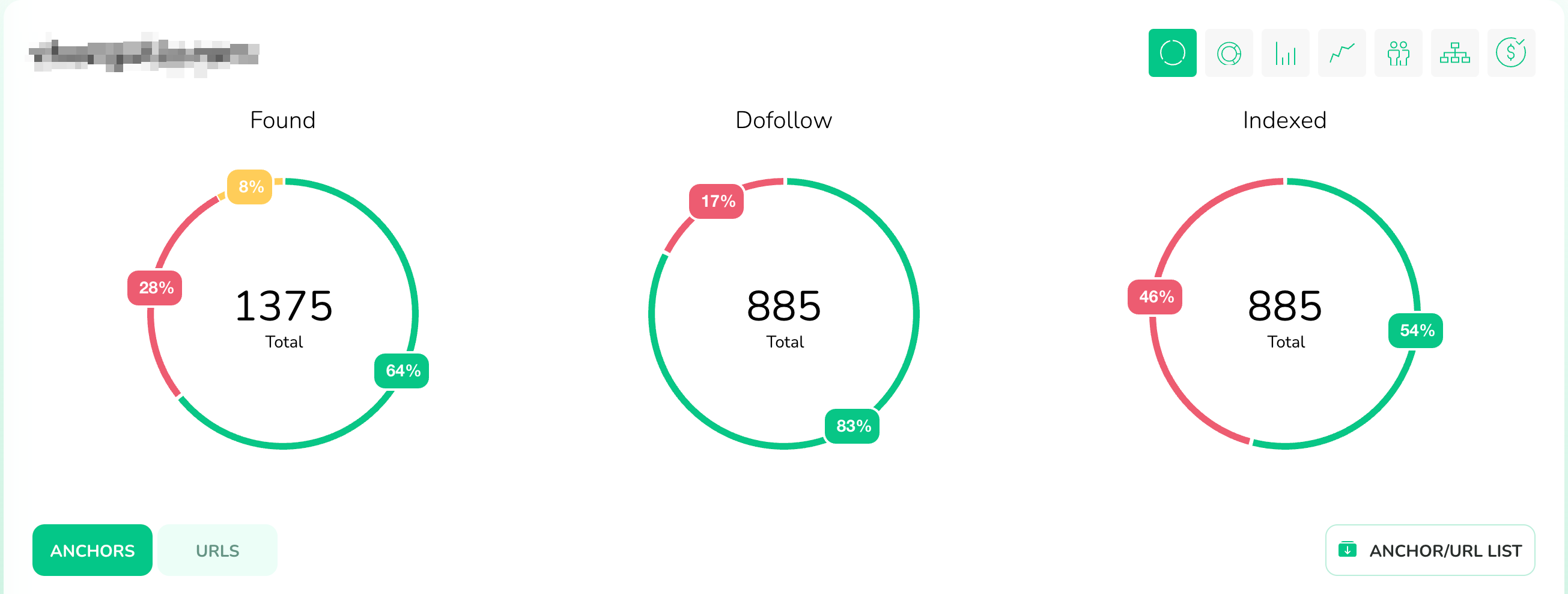
Here’s an example of one of our old reports, and you can see that
- Out of 1,375 backlinks, 28% were most likely lost, and 8% have an “Undefined” status;
- There were 885 dofollow links, 17% of which became nofollow;
- Out of 885 dofollow links, 46% were not indexed.
This is easy to analyze with the tool’s diagrams and graphics.
- Whenever I need to see problematic links, I can filter them out with the necessary metrics:
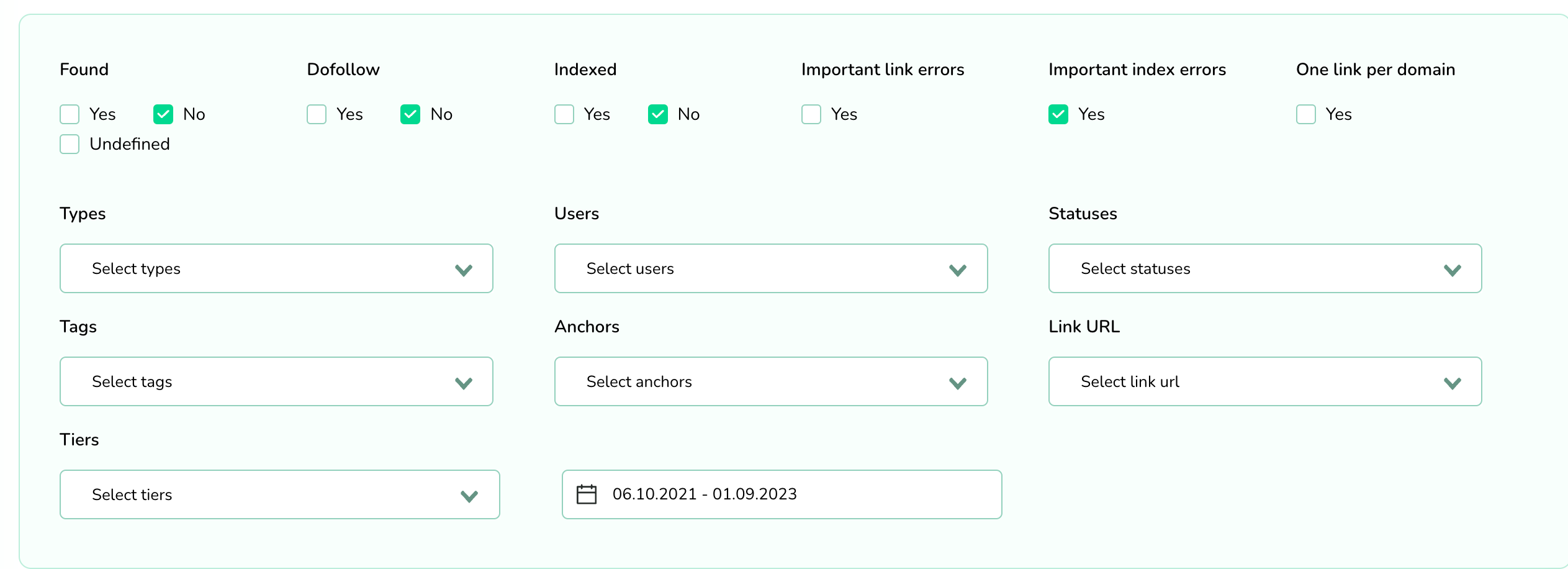
It also allows me to determine which backlinks have an issue and what sort of issue that is:
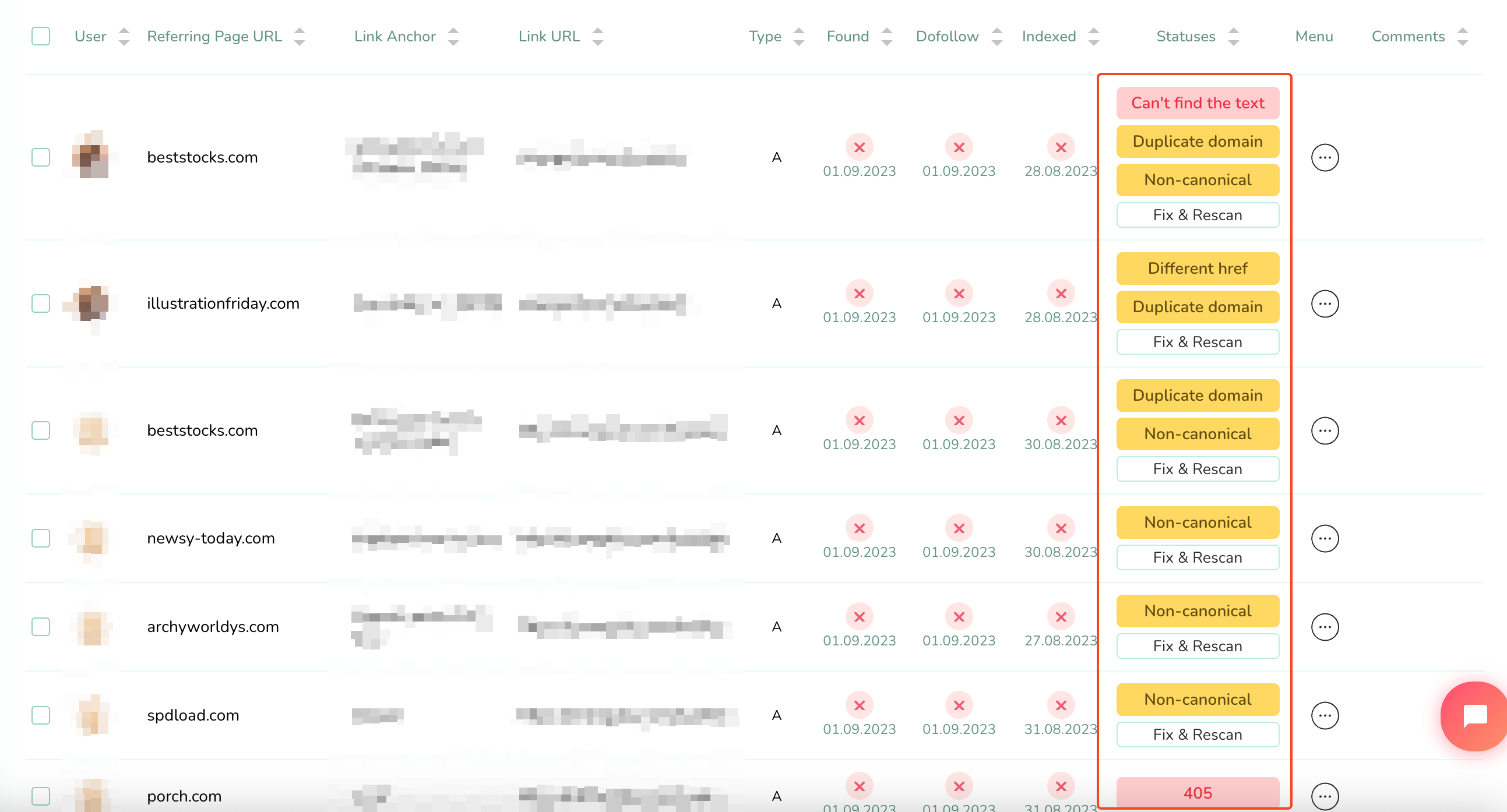
Everything is very clear and concise, and each parameter has a description. This makes the tool accessible to beginners, too.

Conclusion
The highly competitive nature of the crypto industry makes backlink management important for every crypto-related website. It’s not enough to obtain high-quality backlinks; to keep them working and improving your SEO, you also need to manage your website’s backlink profile regularly.
The examples provided in this article come from a website that we don’t work with anymore, but they still show that backlink management is a must. Proper backlink management is key for monitoring your link building processes and reacting to any changes or errors in time.
Combining the practices and strategies discussed above, you can find the best way to manage backlinks for your site. Remember, performing backlink management regularly and systematically is crucial to avoiding unpleasant surprises in your backlink profile.








